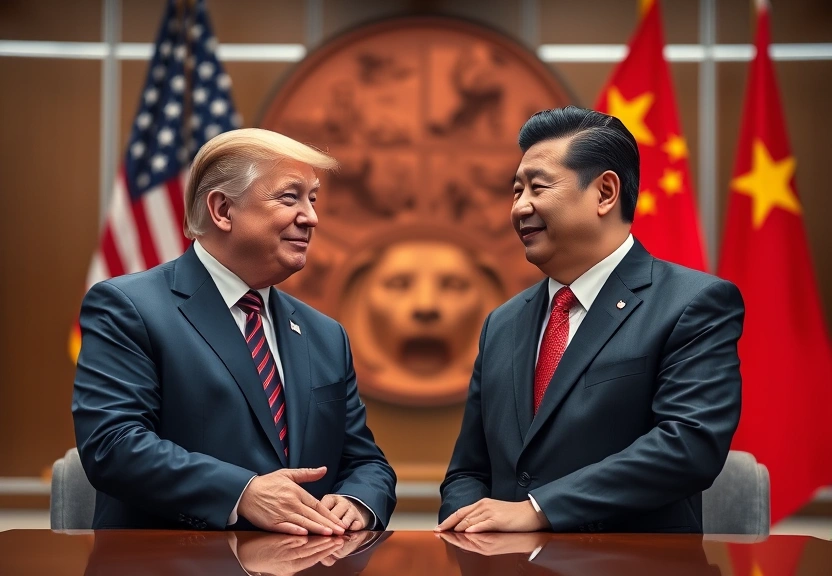US and China Engage in Key Tariff Talks Ahead of Crucial Trump-Xi Meeting
The trade relationship between the United States and China has long been a focal point in international relations, marked by a series of negotiations, tariff implementations, and economic strategies. As both nations prepare for a significant meeting between President Donald Trump and President Xi Jinping, the discourse surrounding US-China tariffs is more crucial than ever. This upcoming meeting not only signifies a potential turning point in economic relations but also reflects broader implications for international trade policy.

With tariffs affecting a myriad of goods and industries, the stakes are high for businesses and consumers alike. The trade negotiations are set against a backdrop of complex economic interdependence, where both countries hold substantial leverage over each other’s markets. In this article, we will delve into the current state of US-China tariffs, the significance of the Trump-Xi meeting, and what these developments mean for global economic stability.
Understanding US-China Tariffs
Tariffs, essentially taxes on imported goods, have been a prominent tool in the trade arsenal of both the US and China. The US has imposed tariffs on a range of Chinese products, which has led to reciprocal tariffs from China on American goods. This tit-for-tat escalation has significantly impacted various sectors, including agriculture, technology, and manufacturing.
The Current Tariff Landscape
As of now, the US has implemented tariffs on approximately $370 billion worth of Chinese imports, while China has responded with tariffs on around $110 billion of US goods. These tariffs have not only affected the prices of goods but have also strained supply chains and disrupted businesses that rely on cross-border trade.
Impact on Consumers and Businesses
The ongoing trade war has led to increased prices for consumers and uncertainty for businesses. Industries such as agriculture have been particularly hard hit, with US farmers facing market access challenges in China. Conversely, Chinese manufacturers have struggled with increased costs due to US tariffs, leading to a ripple effect through the global supply chain.
The Significance of the Trump-Xi Meeting
The upcoming meeting between President Trump and President Xi holds significant weight in the context of US-China relations. As both leaders prepare to engage in discussions, the outcomes could pave the way for future economic policies and trade agreements that benefit both nations.
Objectives of the Meeting
The primary objectives of the Trump-Xi meeting are expected to focus on:
- Reducing tariffs and trade barriers.
- Discussing intellectual property rights and technology transfer issues.
- Addressing the trade imbalance between the two countries.
- Strengthening cooperation on global economic challenges.
Potential Outcomes
While the exact outcomes of the meeting are uncertain, there are several potential scenarios. A successful negotiation could lead to a reduction in tariffs, signaling a thaw in relations and fostering a more cooperative economic environment. Conversely, failure to reach an agreement could result in further escalation, perpetuating the cycle of tariffs and retaliation.
Broader Implications for Economic Relations
The implications of the US-China tariff talks extend far beyond the bilateral relationship between the two superpowers. As global leaders watch closely, the outcomes could reshape international trade policies and economic strategies worldwide.
Impact on Global Markets
Any significant shifts in US-China trade relations will likely have repercussions on global markets. Investors often react to news regarding tariffs, and uncertainty can lead to market volatility. Furthermore, countries that rely heavily on trade with either the US or China may need to recalibrate their economic strategies based on the outcomes of these negotiations.
Shifting Alliances and Trade Partnerships
The ongoing trade tensions have also prompted countries to reconsider their alliances and trade partnerships. For instance, nations may seek to strengthen ties with either the US or China based on perceived economic advantages. This realignment could lead to new trade agreements and partnerships that reshape the global economic landscape.
Future of US-China Trade Negotiations
Looking ahead, the future of US-China trade negotiations remains uncertain, yet crucial. As both countries navigate their economic relationship, a few key considerations will likely shape the path forward.
Continuous Dialogue
For progress to be made, continuous dialogue between US and Chinese officials is essential. Establishing open lines of communication can help prevent misunderstandings and foster a more collaborative approach to trade issues.
Monitoring Trade Policies
Both nations will need to monitor their trade policies closely, adjusting them as needed in response to economic conditions and negotiations. This dynamic approach can help mitigate the adverse effects of tariffs and promote a more stable economic environment.
FAQs about US-China Tariffs and Trade Relations
1. What are the current US-China tariffs?
Currently, the US has imposed tariffs on around $370 billion worth of Chinese imports, while China has retaliated with tariffs on approximately $110 billion of US goods.
2. How do tariffs affect consumers?
Tariffs typically lead to increased prices on imported goods, which can result in higher costs for consumers. Additionally, tariffs can disrupt supply chains and create market uncertainties.
3. What is the significance of the Trump-Xi meeting?
The Trump-Xi meeting is crucial for addressing ongoing trade tensions and could lead to significant changes in tariff policies and economic relations between the two countries.
4. How might trade negotiations impact global markets?
Changes in US-China trade relations can lead to market volatility, impacting investor confidence and prompting countries to reassess their trade partnerships.
5. What are the potential outcomes of the trade talks?
Potential outcomes range from reduced tariffs and improved trade relations to continued escalation of tensions, depending on the negotiations’ success.
Conclusion
The ongoing tariff talks between the US and China are pivotal not only for the two nations but also for the global economy at large. As President Trump and President Xi prepare for their crucial meeting, the ramifications of their discussions will be closely watched by international stakeholders. The resolution of tariff disputes and the establishment of a more cohesive trade framework could lead to renewed economic growth and cooperation, while continued tensions may result in further challenges in international trade policy. Ultimately, the outcome of these negotiations will shape the future of economic relations between the US and China, influencing markets and trade dynamics worldwide.
📰 Original Source
Este artigo foi baseado em informações de: https://www.investing.com/news/stock-market-news/us-china-to-launch-new-talks-on-tariff-truce-extension-easing-path-for-trumpxi-meeting-4154251


